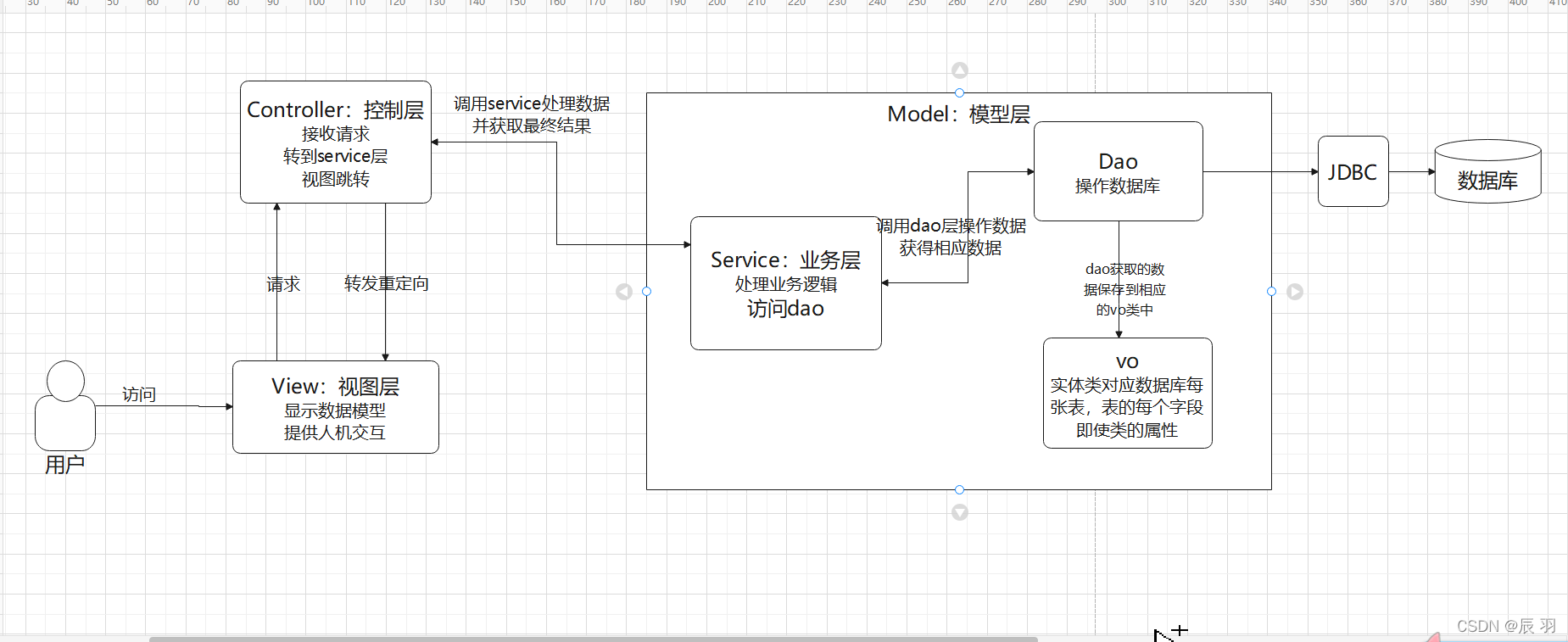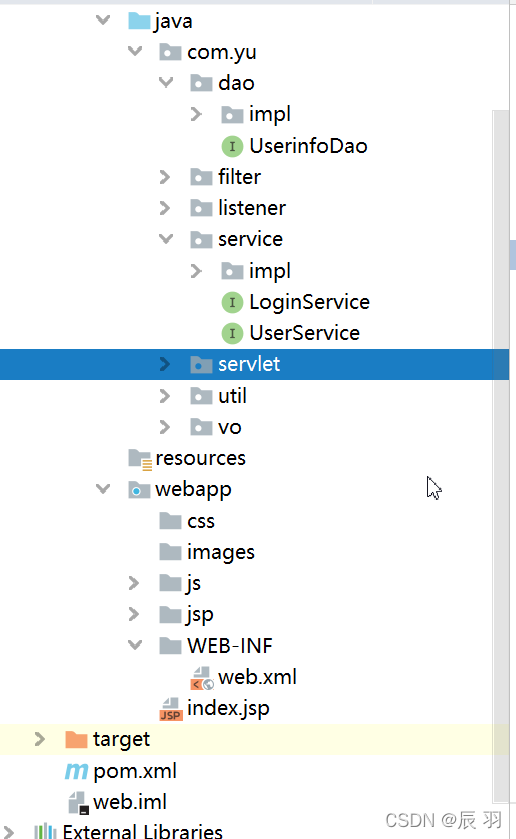完整Servlet程序结构简介
6、程序结构
6.1 MVC介绍
MVC: Model View Controller 模型(vo、dao、service等)、视图(jsp页面)、控制器(servlet)
- Model(模型层):
- 业务逻辑处理
- 操作数据库
- 实体类
- View(视图层):
- 展示数据模型
- 提供人机交互的操作
- Controller(控制层)
- 接收用户的请求
- 转给业务层处理所需数据,获取处理后的数据
- 视图跳转(转发、重定向)

|
1 2 3 4 5 6 7 8 9 10 11 12 13 14 |
主要的基层结构: 1、 View 就是页面的开发。页面分为静态页面和动态页面。用于页面的编写语言有:HTML、DIV+CSS、Javascript、Ajax、ExtJs、Jquery、Jsp。流行的页面框架有:Freemarker、Vue等等。 View页面提交的方式有: A. 通过form 表单提交 B. 在JavaScript中通过Ajax等方式提交 C. 通过浏览器的地址栏直接输入地址 提交 2、Servlet Interface :它的作用是处理从View页面提交过来的请求,并进行处理,然后将请求发送到Web服务器,最后将服务器的响应回送到浏览器。 每个Servlet必须实现javax.servlet.Servlet接口,而Servlet API提供了一个javax.servlet.HttpServlet类来实现Servlet接口。所以代码中只要Extends HttpServlet 就可以了。 Servlet 获取View页面提交过来的数据方式有: 3、ControlServlet extends HttpServlet:当一个类继承了HttpServlet时,只需要在doGet或者doPost方法中写相应的代码即可 4、Services:业务逻辑处理的服务类。ControlServlet获取数据后,调用相应的Services来处理业务逻辑。Services调用DAO-interface的实现类来执行相对应的数据库操作 5、DAO-Interface : DAO是Data Access Object数据访问接口,作为一个数据访问接口层,它主要的作用隐藏数据访问的具体代码,以提高系统的安全性和便利性。作为业务逻辑层的Services不管具体的数据访问代码,它只管调用指定的接口方法。 6、DAO—Implement :数据访问的具体实现类,里面执行对数据库的操作。比如: 查询、删除、修改、新增、执行试图、执行存储过程、创建表机构,删除表机构、修改表结构. 7、DataBase:数据库,存储数据的地方。 |
6.2 大致结构
根据MVC的基本结构在构建项目一般要创建如下的结构:

6.2.1 util包
util包主要封装一些辅助性的工具类,如JDBC连接数据库、封装一些常量等等。
几种常见的工具类:
- JDBC连接数据库添加MySQL的Maven依赖:
|
1 2 3 4 5 6 |
<!--添加mysql的依赖--> <dependency> <groupId>mysql</groupId> <artifactId>mysql-connector-java</artifactId> <version>8.0.23</version> </dependency> |
创建util工具类DBHelper
|
1 2 3 4 5 6 7 8 9 10 11 12 13 14 15 16 17 18 19 20 21 22 23 24 25 26 27 28 29 30 31 32 33 34 35 36 37 38 39 40 41 42 43 44 45 46 47 48 49 50 51 52 53 54 55 56 57 58 59 60 61 62 63 64 65 66 67 68 69 70 71 72 73 |
package com.yu.util; import com.mysql.cj.jdbc.Driver; import sun.security.pkcs11.Secmod; import java.sql.*; public class DBHelper { //创建单例 private DBHelper(){} private static DBHelper dbh = new DBHelper(); public static DBHelper getDbh(){ return dbh; } //创建连接数据库的Connection public Connection linkMysql() throws ClassNotFoundException, SQLException { String url = "jdbc:mysql://ip地址:3306/库名?characterEncoding=utf-8&serverTimezone=Asia/Shanghai&useSSL=false"; String user = "root"; String password = "数据库密码"; //加载驱动 Class.forName("com.mysql.cj.jdbc.Driver"); //连接数据库,Connection相当于数据 Connection conn = DriverManager.getConnection(url,user,password); return conn; } //增删改的操作 public void update(String sql, Object...param) { Connection conn = null; /*执行sql语句的有两个对象:PreparedStatement和Statement 1、PreparedStatement是预编译的,对于批量处理可以大大提高效率. 也叫JDBC存储过程 它第一次执行消耗是很高的. 它的性能体现在后面的重复执行. 2、在对数据库只执行一次性存取的时侯,用 Statement 对象进行处理。 */ PreparedStatement ps = null; try { conn = this.linkMysql(); ps = conn.prepareStatement(sql); //设置sql语句的未知数 for(int i=0; i<param.length; i++){ ps.setObject(i+1,param[i]); } ps.executeUpdate(); } catch (Exception e) { e.printStackTrace(); }finally { this.close(conn,ps,null); } } //关闭 public void close(Connection conn, PreparedStatement ps, ResultSet rs){ if(rs != null){ try { rs.close(); } catch (SQLException e) { e.printStackTrace(); } } try { ps.close(); } catch (SQLException e) { e.printStackTrace(); } try { conn.close(); } catch (SQLException e) { e.printStackTrace(); } } } |
6.2.2 vo包
vo类保存实体对象,每个类对应数据库的一张表,属性为表中每一个字段,如果其中的字段和其他表关联,则改为这个关联表的对象。当dao读取数据库的数据时,相应的数据保存到相应的实体类的对象中。
6.2.3 dao包
dao中的类是对数据库进行操作的,主要是对数据的增删改查等等操作。
dao创建的一般步骤为先创建dao的结构,在创建实现类来实现这个接口。
- 以登陆为例,先创建一个接口
1234567public interface UserinfoDao{Userinfo getUserifoByID(int id);Userinfo verifyUsernameAndPassword(String username , String password);void deleteUserinfoByID(int id);void setPassByID(String newPass ,int id);void addUserinfo(Userinfo userinfo);}
- 实现类
12345678910111213141516171819202122232425262728293031323334353637383940414243444546474849505152535455565758596061626364656667686970717273747576777879808182838485868788899091public class UserinfoDaoImpl implements UserinfoDao {//将实现类创建成单例模式private static UserinfoDaoImpl userinfoDao = null;private UserinfoDaoImpl(){if(userinfoDao!=null){throw new RuntimeException();}}public static UserinfoDaoImpl getUserinfoDaoImpl(){if (userinfoDao == null) {synchronized (UserinfoDaoImpl.class) {if (userinfoDao == null) {userinfoDao = new UserinfoDaoImpl();}}}return userinfoDao;}//实现接口中的方法//根据用户名和密码返回用户,主要用于验证登陆时输入的验证码问题public Userinfo verifyUsernameAndPassword(String username, String password){Connection conn = null;PreparedStatement ps = null;ResultSet rs = null;Userinfo userinfo = null;try {conn = DBHelper.getDbh().linkMysql();String sql = "SELECT user_info.id,user_info.user_name,user_info.password FROM user_info WHERE user_info.user_name=? AND user_info.password=?" ;ps = conn.prepareStatement(sql);//给sql语句中的?赋值ps.setString(1,username);ps.setString(2,password);rs = ps.executeQuery();if (rs.next()){ rs.next(),指针下移,返回值为Booleanuserinfo = new Userinfo();userinfo.setId(rs.getInt("id"));userinfo.setUsername(rs.getString("user_name"));userinfo.setPassword(rs.getString("password"));}} catch (Exception e) {e.printStackTrace();}finally {DBHelper.getDbh().close(conn,ps,rs);}return userinfo;}//根据获取用户信息public Userinfo getUserifoByID(int id){Connection conn = null;PreparedStatement ps = null;ResultSet rs = null;Userinfo user = null;try {conn = DBHelper.getDbh().linkMysql();String sql = "SELECT * FROM user_info WHERE id = ?";ps= conn.prepareStatement(sql);ps.setInt(1,id);rs = ps.executeQuery();if(rs.next()){user = new Userinfo();user.setId(rs.getInt("id"));user.setUsername(rs.getString("user_name"));user.setPassword(rs.getString("password"));}} catch (Exception e) {e.printStackTrace();}finally {DBHelper.getDbh().close(conn,ps,rs);}return user;}//根据id删除用户public void deleteUserinfoByID(int id){String sql = "DELETE FROM user_info WHERE user_info.id = ?";DBHelper.getDbh().update(sql,id);}//根据id修改密码public void setPassByID(String newPass ,int id){String sql = "UPDATE user_info SET user_info.password = ? WHERE user_info.id = ?";DBHelper.getDbh().update(sql,newPass,id);}//增加用户信息public void addUserinfo(Userinfo userinfo){String sql = "INSERT INTO user_info(user_info.user_name,user_info.password) VALUE (?,?)";DBHelper.getDbh().update(sql,userinfo.getUsername(),userinfo.getPassword());}}
6.2.4 jsp页面
进行数据交互和展示数据模型
1、form表单
2、Ajax
|
1 2 3 4 5 6 7 8 9 10 11 12 13 14 15 16 17 18 19 20 21 22 23 24 25 26 27 28 29 30 31 32 33 34 35 36 37 38 39 40 41 |
<%@ page contentType="text/html;charset=UTF-8" language="java" isELIgnored="false" %> <%@ taglib prefix="c" uri="http://java.sun.com/jsp/jstl/core" %> <%@ taglib prefix="fn" uri="http://java.sun.com/jsp/jstl/functions" %> <%@ taglib prefix="fmt" uri="http://java.sun.com/jsp/jstl/fmt" %> <c:set var="path" value="${pageContext.request.contextPath}"/> <%String path = request.getContextPath();%> <html> <head> <title>Title</title> <script src="${path}/js/jquery-3.6.0.min.js"></script> <script> $(function () { //点击退出登陆,注销用户 $("#cancellation").click(function () { window.location="${path}/CancellationServlet"; }); //显示所有用户 $("#showUser").click(function () { $.ajax({ url: "${path}/ShowUserServlet", //请求路径 data:{ //发送的数据 userId: $("#userid").val() }, success:function (data) { //成功后执行的回调函数 $("#showSuccess").html(data); } }); }); }); </script> </head> <body> <span>登陆成功:用户名:${userinfo.username}, 密码:${userinfo.password}</span> <div class="cancellation" id="cancellation">退出登陆</div> <input type="number" id="userid" placeholder="请输入用户id"> <button class="showUser" id="showUser">显示用户</button> <span id="showSuccess"></span> </body> </html> |
6.2.5 servlet
主要是接收前端的数据,进行页面的转发等操作
1、登陆
|
1 2 3 4 5 6 7 8 9 10 11 12 13 14 15 16 17 18 19 20 21 22 23 |
public class LoginServlet extends HttpServlet { @Override protected void doGet(HttpServletRequest request, HttpServletResponse response) throws ServletException, IOException { //获取前端的数据 String username = request.getParameter("username"); String password = request.getParameter("password"); //调用service层处理逻辑 LoginService loginService = new LoginServiceImpl(); Userinfo userinfo = loginService.login(username, password); //userinfo==null说明用户名密码错误 !=null则登陆成功 //进行页面的转发或重定向 if(userinfo != null){ request.getSession().setAttribute(Constant.USER_SESSION,userinfo); //重定向到主页 response.sendRedirect(request.getContextPath()+"/jsp/mainview/success.jsp"); }else{ //转到登陆界面,显示登陆失败 request.setAttribute("error", Constant.LOGIN_FAIL); request.getRequestDispatcher("/jsp/login/login.jsp").forward(request,response); } } } |
2、处理ajax
|
1 2 3 4 5 6 7 8 9 10 11 12 13 14 15 16 |
public class UserServlet extends HttpServlet { @Override protected void doGet(HttpServletRequest request, HttpServletResponse response) throws ServletException, IOException { //获取前端的数据 String userId = request.getParameter("userId"); //调用service层处理逻辑 UserService UserService = new UserServiceImpl(); Userinfo user = UserService.getUser(Integer.valueOf(userId)); //给ajax请求传递数据 if(user==null){ response.getWriter().print("无此人"); }else{ response.getWriter().print("id:"+user.getId()+",用户名:"+user.getUsername()+",密码:"+user.getPassword()); } } } |
6.2.6 service包
service和dao类似,需要先创建一个service的接口,然后通过实现类来实现接口
- 接口
123public interface LoginService {Userinfo login(String username , String password);}
- 实现类
1234567891011121314public class LoginServiceImpl implements LoginService {//获得dao的对象private UserinfoDao userinfoDao;public LoginServiceImpl(){userinfoDao = UserinfoDaoImpl.getUserinfoDaoImpl();}//登陆操作@Overridepublic Userinfo login(String username, String password) {//验证用户名和密码Userinfo userinfo = userinfoDao.verifyUsernameAndPassword(username, password);return userinfo;}}
6.2.7 Filter
…….
6.2.8 Listener
from:https://blog.csdn.net/yuandfeng/article/details/124239134